Goals
- Continue working with clustering and classification algorithms
- Work on linear regression models
- Start working on neural network models including single and multilayered perceptrons.
- Work on decision trees and random forests.
- Work on online machine training.
- Work on neural network models using Tensorflow.
- Continue working on the recommender system
Scoring
Every exercise has an associated difficulty level. Easy and medium-difficult exercises help you understand the fundamentals and give you ideas to work on difficult exercises. It is highly recommended that you finish easy and medium-difficult exercises to have a good score. Given below is the difficulty scale that will be marked for every exercise:
- ★: Easy
- ★★: Medium
- ★★★: Difficult
Guidelines
- To get complete guidance from the mentors, it is highly recommended that you work on today's practical session and not on the preceding ones.
- Make sure that you rename your submission properly and correctly. Double-check your submission.
- Please check the references.
- There are several ways to achieve a task. Hence there are many possible solutions. But try to make maximum use of the libraries that have been suggested to you for your exercises.
Installation
Exercise 3.1 ★
We will now work with linear regression (refer here).
Let's see some simple programs. In the following data, where we have some sample data for the equation: y = x. We will first train our Linear Regression model with a very small subset and test whether it is able to predict y-values for new x-values.
import numpy as np
import matplotlib.pyplot as plot
from sklearn.linear_model import LinearRegression
numarray = np.array([[0,0], [1,1], [2,2], [3,3], [4,4], [5,5]])
lr = LinearRegression()
lr.fit(numarray[:, 0].reshape(-1, 1), numarray[:, 1].reshape(-1, 1))
#printing coefficients
print(lr.intercept_, lr.coef_)
x_predict = np.array([6, 7, 8, 9, 10])
y_predict = lr.predict(x_predict.reshape(-1, 1))
print(y_predict)
Next, we have some sample data for the equation: y = x + 1. We will train our Linear Regression model test whether it is able to predict y-values for new x-values.
import numpy as np
import matplotlib.pyplot as plot
from sklearn.linear_model import LinearRegression
numarray = np.array([[0,1], [1,2], [2,3], [3,4], [4,5], [5,6]])
lr = LinearRegression()
lr.fit(numarray[:, 0].reshape(-1, 1), numarray[:, 1].reshape(-1, 1))
#printing coefficients
print(lr.intercept_, lr.coef_)
x_predict = np.array([6, 7, 8, 9, 10])
y_predict = lr.predict(x_predict.reshape(-1, 1))
print(y_predict)
But, what if we tried the Linear Regression model for the equation: y = x2. What did you observe with the following code? Did it predict the y-values correctly?
import numpy as np
import matplotlib.pyplot as plot
from sklearn.linear_model import LinearRegression
numarray = np.array([[0,0], [1,1], [2,4], [3,9], [4,16], [5,25]])
lr = LinearRegression()
lr.fit(numarray[:, 0].reshape(-1, 1), numarray[:, 1].reshape(-1, 1))
#printing coefficients
print(lr.intercept_, lr.coef_)
x_predict = np.array([6, 7, 8, 9, 10])
y_predict = lr.predict(x_predict.reshape(-1, 1))
print(y_predict)
Now, Let's repeat the above experiment by making use of Polynomial features. Try changing the value of degree in the code given below.
import numpy as np
import matplotlib.pyplot as plot
from sklearn.linear_model import LinearRegression
from sklearn.preprocessing import PolynomialFeatures
numarray = np.array([[0,0], [1,1], [2,4], [3,9], [4,16], [5,25]])
#using polynomial features
pf = PolynomialFeatures(degree=2)
x_poly = pf.fit_transform(numarray[:, 0].reshape(-1, 1))
lr = LinearRegression()
lr.fit(x_poly, numarray[:, 1].reshape(-1, 1))
#printing coefficients
print(lr.intercept_, lr.coef_)
x_predict = np.array([6, 7, 8, 9, 10])
y_predict = lr.predict(pf.fit_transform(x_predict.reshape(-1, 1)))
print(y_predict)
Now let's try with third order polynomial equation (cubic equation).
import numpy as np
import matplotlib.pyplot as plot
from sklearn.linear_model import LinearRegression
from sklearn.preprocessing import PolynomialFeatures
numarray = np.array([[0,0], [1,1], [2,8], [3,27], [4,64], [5,125]])
#using polynomial features
pf = PolynomialFeatures(degree=3)
x_poly = pf.fit_transform(numarray[:, 0].reshape(-1, 1))
lr = LinearRegression()
lr.fit(x_poly, numarray[:, 1].reshape(-1, 1))
#printing coefficients
print(lr.intercept_, lr.coef_)
x_predict = np.array([6, 7, 8, 9, 10])
y_predict = lr.predict(pf.fit_transform(x_predict.reshape(-1, 1)))
print(y_predict)
Download the file population.csv (source: query given in references). We will first plot this multi-annual population.
import numpy as np
import matplotlib.pyplot as plot
import pandas as pd
dataset = np.loadtxt("population.csv", dtype={'names': ('year', 'population'), 'formats': ('i4', 'i')},
skiprows=1, delimiter=",", encoding="UTF-8")
df = pd.DataFrame(dataset)
df.plot(x='year', y='population', kind='scatter')
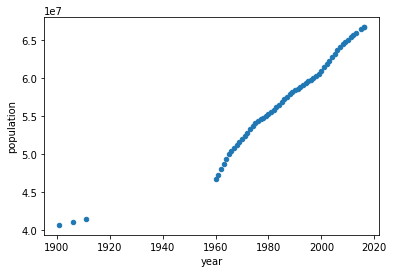
We will focus on data starting from 1960 (why?). Our goal is to use regression techniques to predict population. But we don't know how to verify. So with the available data, we create two categories: training data and test data.
Now continuing with the population data (from TP1 and TP2), we split it into two: training data and test data. We will plot the actual population values and the predicted values.
import numpy as np
import matplotlib.pyplot as plot
import pandas as pd
from sklearn.linear_model import LinearRegression
dataset = np.loadtxt("population.csv", dtype={'names': ('year', 'population'), 'formats': ('i4', 'i')},
skiprows=1, delimiter=",", encoding="UTF-8")
df = pd.DataFrame(dataset[4:])
#training data
x_train = df['year'][:40].values.reshape(-1, 1)
y_train = df['population'][:40].values.reshape(-1, 1)
#training
lr = LinearRegression()
lr.fit(x_train, y_train)
#printing coefficients
print(lr.intercept_, lr.coef_)
#prediction
x_predict = x_train = df['year'][41:].values.reshape(-1, 1)
y_actual = df['population'][41:].values.reshape(-1, 1)
y_predict = lr.predict(x_predict)
plot.scatter(x_predict, y_actual)
plot.plot(x_predict, y_predict, color='red', linewidth=2)
plot.show()
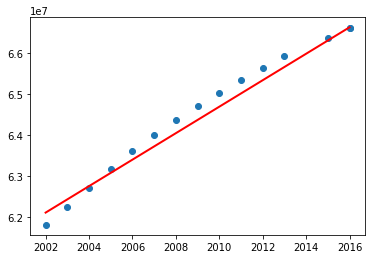
Now test the above program including the data before 1960. What did you notice? You may have got the following graph.
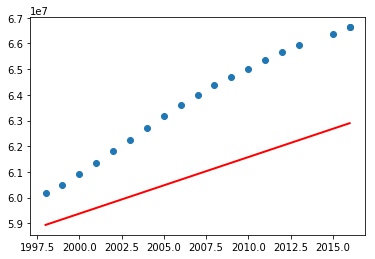
What are your observations? So the above program using linear regression perfectly fit for a subset of data. Let's now try with polynomial features with degree 2 (refer Polynomial Regression: Extending linear models).
import numpy as np
import matplotlib.pyplot as plot
import pandas as pd
from sklearn.linear_model import LinearRegression
from sklearn.preprocessing import PolynomialFeatures
dataset = np.loadtxt("population.csv", dtype={'names': ('year', 'population'), 'formats': ('i4', 'i')},
skiprows=1, delimiter=",", encoding="UTF-8")
df = pd.DataFrame(dataset[4:])
#training data
x_train = df['year'][:50].values.reshape(-1, 1)
y_train = df['population'][:50].values.reshape(-1, 1)
pf = PolynomialFeatures(degree=2)
x_poly = pf.fit_transform(x_train)
#training
lr = LinearRegression()
lr.fit(x_poly, y_train)
#printing coefficients
print(lr.intercept_, lr.coef_)
#prediction
x_predict = x_train = df['year'][41:].values.reshape(-1, 1)
y_actual = df['population'][41:].values.reshape(-1, 1)
y_predict = lr.predict(pf.fit_transform(x_predict))
plot.scatter(x_predict, y_actual)
plot.plot(x_predict, y_predict, color='red', linewidth=2)
plot.show()
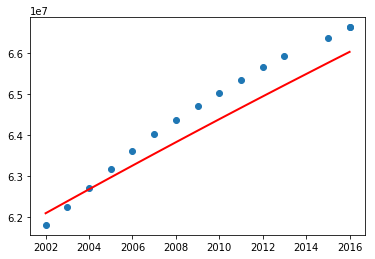
Before jumping into a conclusion, let's consider the entire data and see.
import numpy as np
import matplotlib.pyplot as plot
import pandas as pd
from sklearn.linear_model import LinearRegression
from sklearn.preprocessing import PolynomialFeatures
dataset = np.loadtxt("population.csv", dtype={'names': ('year', 'population'), 'formats': ('i4', 'i')},
skiprows=1, delimiter=",", encoding="UTF-8")
df = pd.DataFrame(dataset)
#training data
x_train = df['year'][:40].values.reshape(-1, 1)
y_train = df['population'][:40].values.reshape(-1, 1)
pf = PolynomialFeatures(degree=2)
x_poly = pf.fit_transform(x_train)
#training
lr = LinearRegression()
lr.fit(x_poly, y_train)
#printing coefficients
print(lr.intercept_, lr.coef_)
#prediction
x_predict = x_train = df['year'][41:].values.reshape(-1, 1)
# Let's add some more years
x_predict = np.append(range(1900, 1959), x_predict)
x_predict = x_predict.reshape(-1, 1)
y_actual = df['population'][41:].values.reshape(-1, 1)
y_predict = lr.predict(pf.fit_transform(x_predict))
plot.scatter(df['year'], df['population'])
plot.plot(x_predict, y_predict, color='red', linewidth=2)
plot.show()
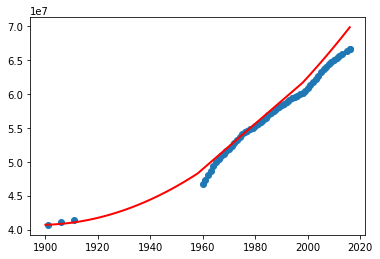
What do you think? Can we use this program to predict the missing data (especially in the absence of other external source of information)? Try the above program with different degrees.
Exercise 3.2 ★★
Classifiers are helpful to classify our dataset into one or more classes. But unlike clustering algorithms, it's the user who has to classify the data in a classification algorithm. In the following exercises, we see different classifiers, starting with perceptron. Look at the input data (numarray) and the associated labels (result). Here, we will label the complete dataset and see whether our model (Perceptron) did work well.
import numpy as np
import matplotlib.pyplot as plot
from sklearn.linear_model import Perceptron
numarray = np.array([[0,0,0,0], [0,0,0,1], [0,0,1,0], [0,0,1,1],
[0,1,0,0], [0,1,0,1], [0,1,1,0], [0,1,1,1],
[1,0,0,0], [1,0,0,1], [1,0,1,0], [1,0,1,1],
[1,1,0,0], [1,1,0,1], [1,1,1,0], [1,1,1,1]])
result = np.array([0, 0, 0, 0,
0, 0, 0, 0,
1, 1, 1, 1,
1, 1, 1, 1])
perceptron = Perceptron(max_iter=1000)
perceptron.fit(numarray, result)
x_predict = np.array([[0,1,0,1], [1,0,1,1] ])
y_predict = perceptron.predict(x_predict)
print(y_predict)
Now we will remove some labeled/classified data and see the predicted results.
import numpy as np
import matplotlib.pyplot as plot
from sklearn.linear_model import Perceptron
numarray = np.array([[0,0,0,0], [0,0,0,1],
[0,1,0,0], [0,1,1,1],
[1,0,0,1], [1,0,1,0],
[1,1,1,0], [1,1,1,1]])
result = np.array([0, 0,
0, 0,
1, 1,
1, 1])
perceptron = Perceptron(max_iter=1000)
perceptron.fit(numarray, result)
x_predict = np.array([[0,1,0,1], [1,0,1,1], [1,1,0,0], [0,1,0,1]])
y_predict = perceptron.predict(x_predict)
print(y_predict)
Now, we will try another classifer: MLPClassifier
import numpy as np
import matplotlib.pyplot as plot
from sklearn.neural_network import MLPClassifier
numarray = np.array([[0,0,0,0], [0,0,0,1],
[0,1,0,0], [0,1,1,1],
[1,0,0,1], [1,0,1,0],
[1,1,1,0], [1,1,1,1]])
result = np.array([0, 0,
0, 0,
1, 1,
1, 1])
mlpclassifier = MLPClassifier(alpha=2, max_iter=1000)
mlpclassifier.fit(numarray, result)
x_predict = np.array([[0,1,0,1], [1,0,1,1], [1,1,0,0], [0,1,0,1]])
y_predict = mlpclassifier.predict(x_predict)
print(y_predict)
Now, we will try another classifer using support vector machines.
import numpy as np
import matplotlib.pyplot as plot
from sklearn import datasets, svm, metrics
numarray = numarray = np.array([[0,0,0,0], [0,0,0,1],
[0,1,0,0], [0,1,1,1],
[1,0,0,1], [1,0,1,0],
[1,1,1,0], [1,1,1,1]])
result = np.array([0, 0,
0, 0,
1, 1,
1, 1])
svcclassifier = svm.SVC(gamma=0.001, C=100.)
svcclassifier.fit(numarray, result)
x_predict = np.array([[0,1,0,1], [1,0,1,1], [1,1,0,0], [0,1,0,1]])
y_predict = svcclassifier.predict(x_predict)
print(y_predict)
We will now use scikit-learn and the classifiers seen above to recognize handwriting. Scikit-learn has a lot of datasets. We will use one such dataset called digits dataset, which consists of labeled handwriting images of digits. The following program will show the labels.
from sklearn import datasets
import numpy as np
digits = datasets.load_digits()
print(np.unique(digits.target))
We will now see the total number of images and the contents of one test image.
from sklearn import datasets
import numpy as np
import matplotlib.pyplot as plot
digits = datasets.load_digits()
print("Number of images: ", digits.images.size)
print("Input data: ", digits.images[0])
print("Label:", digits.target[0])
plot.imshow(digits.images[0], cmap=plot.cm.gray_r)
plot.show()
We will now use a support vector classifier to train the data. We will split our data into two: training data and test data. Remember that we already have labels for the entire dataset.
from sklearn import datasets, svm
import numpy as np
import matplotlib.pyplot as plot
digits = datasets.load_digits()
training_images = digits.images[:int(digits.images.shape[0]/2)]
training_images = training_images.reshape((training_images.shape[0], -1))
training_target = digits.target[0:int(digits.target.shape[0]/2)]
classifier = svm.SVC(gamma=0.001, C=100.)
#training
classifier.fit(training_images, training_target)
#prediction
predict_image = digits.images[int(digits.images.shape[0]/2)+2]
print("Predicted value: ", classifier.predict(predict_image.reshape(1,-1)))
plot.imshow(predict_image, cmap=plot.cm.gray_r)
plot.show()
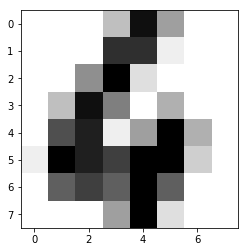
Now let's try predicting the remaining labels and use the classifcation report to get the precision of prediction.
from sklearn import datasets, svm, metrics
import numpy as np
import matplotlib.pyplot as plot
digits = datasets.load_digits()
training_images = digits.images[:int(digits.images.shape[0]/2)]
training_images = training_images.reshape((training_images.shape[0], -1))
training_target = digits.target[0:int(digits.target.shape[0]/2)]
classifier = svm.SVC(gamma=0.001, C=100.)
#training
classifier.fit(training_images, training_target)
#prediction
predict_images = digits.images[int(digits.images.shape[0]/2)+1:]
actual_labels = digits.target[int(digits.target.shape[0]/2)+1:]
predicted_labels = classifier.predict(predict_images.reshape((predict_images.shape[0], -1)))
#classification report
print(metrics.classification_report(actual_labels,predicted_labels))
There are other classifiers available. We will now work with Perceptron (refer here) and see its performance.
from sklearn import datasets, metrics
from sklearn.linear_model import Perceptron
import numpy as np
import matplotlib.pyplot as plot
digits = datasets.load_digits()
training_images = digits.images[:int(digits.images.shape[0]/2)]
training_images = training_images.reshape((training_images.shape[0], -1))
training_target = digits.target[0:int(digits.target.shape[0]/2)]
classifier = Perceptron(max_iter=1000)
#training
classifier.fit(training_images, training_target)
#prediction
predict_images = digits.images[int(digits.images.shape[0]/2)+1:]
actual_labels = digits.target[int(digits.target.shape[0]/2)+1:]
predicted_labels = classifier.predict(predict_images.reshape((predict_images.shape[0], -1)))
#classification report
print(metrics.classification_report(actual_labels,predicted_labels))
Finally, we will finish the test with Multilayer Perceptron (refer here).
from sklearn import datasets, metrics
from sklearn.neural_network import MLPClassifier
import numpy as np
import matplotlib.pyplot as plot
digits = datasets.load_digits()
training_images = digits.images[:int(digits.images.shape[0]/2)]
training_images = training_images.reshape((training_images.shape[0], -1))
training_target = digits.target[0:int(digits.target.shape[0]/2)]
classifier = MLPClassifier(alpha=2, max_iter=1000)
#training
classifier.fit(training_images, training_target)
#prediction
predict_images = digits.images[int(digits.images.shape[0]/2)+1:]
actual_labels = digits.target[int(digits.target.shape[0]/2)+1:]
predicted_labels = classifier.predict(predict_images.reshape((predict_images.shape[0], -1)))
#classification report
print(metrics.classification_report(actual_labels,predicted_labels))
Did you try changing the number of hidden layers?
What are your observations after trying the different classifiers?
Your next question is to plot the confusion metrics for all the above three classifiers.
Exercise 3.3 ★★
In this practical session, we start experimenting with decision trees. We will first build a Decision Tree Classifier using a very simple example. Like the classifiers we have seen before, we will first try to fit our data and then predict a class for a previously unseen value.
from sklearn import tree
data = [[0, 0],
[1, 1],
[1, 0]]
result = [1, 0, 1]
dtc = tree.DecisionTreeClassifier()
dtc = dtc.fit(data, result)
dtc.predict([[1, 1]])
Our next goal is to visualize the decision tree. Look at the following code and see how we have given names to the two columns of the above data. We also gave name names to the result data entries, calling them class1 and class2.
from sklearn import tree
import graphviz
import pydotplus
from IPython.display import Image, display
data = [[0, 0],
[1, 1],
[1, 0]]
result = [1, 0, 1]
dtc = tree.DecisionTreeClassifier()
dtc = dtc.fit(data, result)
dot_data = tree.export_graphviz(dtc, out_file=None,
feature_names=['column1', 'column2'],
filled=True, rounded=True,
class_names = ['class1', 'class2']
)
graph = graphviz.Source(dot_data)
pydot_graph = pydotplus.graph_from_dot_data(dot_data)
img = Image(pydot_graph.create_png())
display(img)
Now, let's take some realistic example. In the following code, we consider 13 photographs marked by a user as 'Favorite' and 'NotFavorite'. For every photograph: we have four information: color, tag, size (medium sized, thumbnail etc.) and mode in which the photograph was taken (portrait or landscape). We will build a Decision Tree Classifier with this data. We will then predict whether our user will like a photograph of nature which has a predominant color red, of thumbnail size and taken in portrait mode.
In the following code, we display two values. We predict whether the user will favorite the photograph or not. We also display the importance of each of the features: color, tag, size and mode.
from sklearn import tree
import pandas as pd
from sklearn.preprocessing import LabelEncoder
data = [
['green', 'nature', 'thumbnail', 'landscape'],
['blue', 'architecture', 'medium', 'portrait'],
['blue', 'people', 'medium', 'landscape'],
['yellow', 'nature', 'medium', 'portrait'],
['green', 'nature', 'thumbnail', 'landscape'],
['blue', 'people', 'medium', 'landscape'],
['blue', 'nature', 'thumbnail', 'portrait'],
['yellow', 'architecture', 'thumbnail', 'landscape'],
['blue', 'people', 'medium', 'portrait'],
['yellow', 'nature', 'medium', 'landscape'],
['yellow', 'people', 'thumbnail', 'portrait'],
['blue', 'people', 'medium', 'landscape'],
['red', 'architecture', 'thumbnail','landscape']]
result = [
'Favorite',
'NotFavorite',
'Favorite',
'Favorite',
'Favorite',
'Favorite',
'Favorite',
'NotFavorite',
'NotFavorite',
'Favorite',
'Favorite',
'NotFavorite',
'NotFavorite'
]
#creating dataframes
dataframe = pd.DataFrame(data, columns=['color', 'tag', 'size', 'mode'])
resultframe = pd.DataFrame(result, columns=['favorite'])
#generating numerical labels
le1 = LabelEncoder()
dataframe['color'] = le1.fit_transform(dataframe['color'])
le2 = LabelEncoder()
dataframe['tag'] = le2.fit_transform(dataframe['tag'])
le3 = LabelEncoder()
dataframe['size'] = le3.fit_transform(dataframe['size'])
le4 = LabelEncoder()
dataframe['mode'] = le4.fit_transform(dataframe['mode'])
le5 = LabelEncoder()
resultframe['favorite'] = le5.fit_transform(resultframe['favorite'])
#Use of decision tree classifiers
dtc = tree.DecisionTreeClassifier()
dtc = dtc.fit(dataframe, resultframe)
#prediction
prediction = dtc.predict([
[le1.transform(['red'])[0], le2.transform(['nature'])[0],
le3.transform(['thumbnail'])[0], le4.transform(['portrait'])[0]]])
print(le5.inverse_transform(prediction))
print(dtc.feature_importances_)
What are your observations?
Our next goal is to visualize the above decision tree. Test the code below. It's similar to the code we tested before. Take a look at the classes and the features.
from sklearn import tree
import pandas as pd
from sklearn.preprocessing import LabelEncoder
import graphviz
import pydotplus
from IPython.display import Image, display
data = [
['green', 'nature', 'thumbnail', 'landscape'],
['blue', 'architecture', 'medium', 'portrait'],
['blue', 'people', 'medium', 'landscape'],
['yellow', 'nature', 'medium', 'portrait'],
['green', 'nature', 'thumbnail', 'landscape'],
['blue', 'people', 'medium', 'landscape'],
['blue', 'nature', 'thumbnail', 'portrait'],
['yellow', 'architecture', 'thumbnail', 'landscape'],
['blue', 'people', 'medium', 'portrait'],
['yellow', 'nature', 'medium', 'landscape'],
['yellow', 'people', 'thumbnail', 'portrait'],
['blue', 'people', 'medium', 'landscape'],
['red', 'architecture', 'thumbnail','landscape']]
result = [
'Favorite',
'NotFavorite',
'Favorite',
'Favorite',
'Favorite',
'Favorite',
'Favorite',
'NotFavorite',
'NotFavorite',
'Favorite',
'Favorite',
'NotFavorite',
'NotFavorite'
]
#creating dataframes
dataframe = pd.DataFrame(data, columns=['color', 'tag', 'size', 'mode'])
resultframe = pd.DataFrame(result, columns=['favorite'])
#generating numerical labels
le1 = LabelEncoder()
dataframe['color'] = le1.fit_transform(dataframe['color'])
le2 = LabelEncoder()
dataframe['tag'] = le2.fit_transform(dataframe['tag'])
le3 = LabelEncoder()
dataframe['size'] = le3.fit_transform(dataframe['size'])
le4 = LabelEncoder()
dataframe['mode'] = le4.fit_transform(dataframe['mode'])
le5 = LabelEncoder()
resultframe['favorite'] = le5.fit_transform(resultframe['favorite'])
#Use of decision tree classifiers
dtc = tree.DecisionTreeClassifier()
dtc = dtc.fit(dataframe, resultframe)
dot_data = tree.export_graphviz(dtc, out_file=None,
feature_names=dataframe.columns,
filled=True, rounded=True,
class_names =
le5.inverse_transform(
resultframe.favorite.unique())
)
graph = graphviz.Source(dot_data)
pydot_graph = pydotplus.graph_from_dot_data(dot_data)
img = Image(pydot_graph.create_png())
display(img)
What if we had a possibility of multiple decision trees? Let's predict using a Random Forest Classifier (can be seen as a collection of multiple decision trees). Check the predicted value as well as the importance of the different features. Note that we are asking to create 10 such estimators using a maximum depth of 2 for each of the estimator.
from sklearn import tree
import pandas as pd
from sklearn.ensemble import RandomForestClassifier
from sklearn.preprocessing import LabelEncoder
import graphviz
import pydotplus
from IPython.display import Image, display
data = [
['green', 'nature', 'thumbnail', 'landscape'],
['blue', 'architecture', 'medium', 'portrait'],
['blue', 'people', 'medium', 'landscape'],
['yellow', 'nature', 'medium', 'portrait'],
['green', 'nature', 'thumbnail', 'landscape'],
['blue', 'people', 'medium', 'landscape'],
['blue', 'nature', 'thumbnail', 'portrait'],
['yellow', 'architecture', 'thumbnail', 'landscape'],
['blue', 'people', 'medium', 'portrait'],
['yellow', 'nature', 'medium', 'landscape'],
['yellow', 'people', 'thumbnail', 'portrait'],
['blue', 'people', 'medium', 'landscape'],
['red', 'architecture', 'thumbnail','landscape']]
result = [
'Favorite',
'NotFavorite',
'Favorite',
'Favorite',
'Favorite',
'Favorite',
'Favorite',
'NotFavorite',
'NotFavorite',
'Favorite',
'Favorite',
'NotFavorite',
'NotFavorite'
]
#creating dataframes
dataframe = pd.DataFrame(data, columns=['color', 'tag', 'size', 'mode'])
resultframe = pd.DataFrame(result, columns=['favorite'])
#generating numerical labels
le1 = LabelEncoder()
dataframe['color'] = le1.fit_transform(dataframe['color'])
le2 = LabelEncoder()
dataframe['tag'] = le2.fit_transform(dataframe['tag'])
le3 = LabelEncoder()
dataframe['size'] = le3.fit_transform(dataframe['size'])
le4 = LabelEncoder()
dataframe['mode'] = le4.fit_transform(dataframe['mode'])
le5 = LabelEncoder()
resultframe['favorite'] = le5.fit_transform(resultframe['favorite'])
#Use of random forest classifier
rfc = RandomForestClassifier(n_estimators=10, max_depth=2,
random_state=0)
rfc = rfc.fit(dataframe, resultframe.values.ravel())
#prediction
prediction = rfc.predict([
[le1.transform(['red'])[0], le2.transform(['nature'])[0],
le3.transform(['thumbnail'])[0], le4.transform(['portrait'])[0]]])
print(le5.inverse_transform(prediction))
print(rfc.feature_importances_)
Finally we visualize these estimators.
from sklearn import tree
import pandas as pd
from sklearn.ensemble import RandomForestClassifier
from sklearn.preprocessing import LabelEncoder
import graphviz
import pydotplus
from IPython.display import Image, display
data = [
['green', 'nature', 'thumbnail', 'landscape'],
['blue', 'architecture', 'medium', 'portrait'],
['blue', 'people', 'medium', 'landscape'],
['yellow', 'nature', 'medium', 'portrait'],
['green', 'nature', 'thumbnail', 'landscape'],
['blue', 'people', 'medium', 'landscape'],
['blue', 'nature', 'thumbnail', 'portrait'],
['yellow', 'architecture', 'thumbnail', 'landscape'],
['blue', 'people', 'medium', 'portrait'],
['yellow', 'nature', 'medium', 'landscape'],
['yellow', 'people', 'thumbnail', 'portrait'],
['blue', 'people', 'medium', 'landscape'],
['red', 'architecture', 'thumbnail','landscape']]
result = [
'Favorite',
'NotFavorite',
'Favorite',
'Favorite',
'Favorite',
'Favorite',
'Favorite',
'NotFavorite',
'NotFavorite',
'Favorite',
'Favorite',
'NotFavorite',
'NotFavorite'
]
#creating dataframes
dataframe = pd.DataFrame(data, columns=['color', 'tag', 'size', 'mode'])
resultframe = pd.DataFrame(result, columns=['favorite'])
#generating numerical labels
le1 = LabelEncoder()
dataframe['color'] = le1.fit_transform(dataframe['color'])
le2 = LabelEncoder()
dataframe['tag'] = le2.fit_transform(dataframe['tag'])
le3 = LabelEncoder()
dataframe['size'] = le3.fit_transform(dataframe['size'])
le4 = LabelEncoder()
dataframe['mode'] = le4.fit_transform(dataframe['mode'])
le5 = LabelEncoder()
resultframe['favorite'] = le5.fit_transform(resultframe['favorite'])
#Use of decision tree classifiers
rfc = RandomForestClassifier(n_estimators=10, max_depth=3,
random_state=0,)
rfc = rfc.fit(dataframe, resultframe.values.ravel())
for i in range(10):
dot_data = tree.export_graphviz(rfc.estimators_[i], out_file=None,
feature_names=dataframe.columns,
filled=True, rounded=True,
class_names =
le5.inverse_transform(
resultframe.favorite.unique())
)
graph = graphviz.Source(dot_data)
pydot_graph = pydotplus.graph_from_dot_data(dot_data)
img = Image(pydot_graph.create_png())
display(img)
Exercise 3.4 ★★
We now split our MNIST (handwriting) data into two: training data and test data for creating models for prediction and we fed the complete training data to our classifier. However, in real life, we may have new data to train. Check the following code using perceptron and compare it with the code of exercise 3.3
from sklearn import datasets, metrics
from sklearn.linear_model import Perceptron
import numpy as np
import matplotlib.pyplot as plot
digits = datasets.load_digits()
training_size = int(digits.images.shape[0]/2)
training_images = digits.images[0:training_size]
training_images = training_images.reshape((training_images.shape[0], -1))
training_target = digits.target[0:training_size]
classifier = Perceptron(max_iter=1000)
#training
for i in range(training_size):
training_data = np.array(training_images[i])
training_data = training_data.reshape(1, -1)
classifier.partial_fit(training_data, [training_target[i]], classes=np.unique(digits.target))
#prediction
predict_images = digits.images[training_size+1:]
actual_labels = digits.target[training_size+1:]
predicted_labels = classifier.predict(predict_images.reshape((predict_images.shape[0], -1)))
#classification report
print(metrics.classification_report(actual_labels,predicted_labels))
This approach is called online machine training (or algorithme d'apprentissage incrémental (fr)). Did you get good precision?
Your next question is to modify the above program and test online training with MLPClassifier.
Try modifying (reducing and increasing) the training data size. What are your observations?
Exercise 3.5 ★★
Your final exercise is to use Tensorflow. We will use a Deep Neural Network (DNN) classifier with two hidden layers.
Recall that we have already used Multilayer perceptron (MLP), a subset of Deep Neural Network in our preceding practical session. We will first predict an image of a digit using DNNClassifier.
import tensorflow as tf
from sklearn import datasets
import matplotlib.pyplot as plot
digits = datasets.load_digits()
training_size = int(digits.images.shape[0]/2)
training_images = digits.images[0:training_size]
training_images = training_images.reshape((training_images.shape[0], -1))
training_target = digits.target[0:training_size]
classifier = tf.contrib.learn.DNNClassifier(
feature_columns=[tf.contrib.layers.real_valued_column("", dtype=tf.float64)],
# 2 hidden layers of 50 nodes each
hidden_units=[50, 50],
# 10 classes: 0, 1, 2...9
n_classes=10)
#training
classifier.fit(training_images, training_target, steps=100)
#prediction
predict_images = digits.images[training_size+1:]
predict = classifier.predict(predict_images[16].reshape(1,-1))
print(list(predict))
plot.imshow(predict_images[16], cmap=plot.cm.gray_r)
plot.show()
Did it work? Let's now try to get the accuracy of our model. Will it work for our entire test data?
import tensorflow as tf
from sklearn import datasets
import matplotlib.pyplot as plot
digits = datasets.load_digits()
training_size = int(digits.images.shape[0]/2)
training_images = digits.images[0:training_size]
training_images = training_images.reshape((training_images.shape[0], -1))
training_target = digits.target[0:training_size]
classifier = tf.contrib.learn.DNNClassifier(
feature_columns=[tf.contrib.layers.real_valued_column("", dtype=tf.float64)],
# 2 hidden layers of 50 nodes each
hidden_units=[50, 50],
# 10 classes: 0, 1, 2...9
n_classes=10)
#training
classifier.fit(training_images, training_target, steps=100)
#prediction
predict_images = digits.images[training_size+1:]
actual_labels = digits.target[training_size+1:]
evaluation = classifier.evaluate(x=predict_images.reshape((predict_images.shape[0], -1)), y=actual_labels)
print(evaluation['accuracy'])
What is the accuracy that you got? Now change the number of neurons in each layer (currently it is set to 50 each). Also try to increase the number of hidden layers. Did your accuracy improve?
Exercise 3.5 ★★★
Project: Image recommender system: 3 practical sessions
Recall that the goal of this project is to recommend images based on the color preferences of the user. We will build this system in three practical sessions.
During your last practical session, you collected images and obtained the predominant colors in each image. Now with your knowledge in different types of classifiers and clustering algorithms, what more information will you add for every image?
For every image, you already may have the following information. If not, you can obtain these information based on the exercises already done so far.
- Predominant colors in an image
- Image size
- How about asking users to tag the images? E.g., colors, cat, flower, sunflower, rose etc.
- ...
Ask the user to select some images. We may assume that those images contain the favorite colors of the user, or other favorite characteristics. For every user, you are now in a position to build user-preference profile
- Favorite colors
- Favorite image sizes (thumbnail images, large images, medium-size images etc.)
- Tags
- ...
Are you now in a position to recommend images to a user? What's missing? What are the limitations of your proposed approach?
Submission
- Rename your notebook as Name1_Name2_[Name3].ipynb, where Name1, Name2 are your names.
- Submit your notebook online.
- Please don't submit your JSON, TSV and CSV files.
